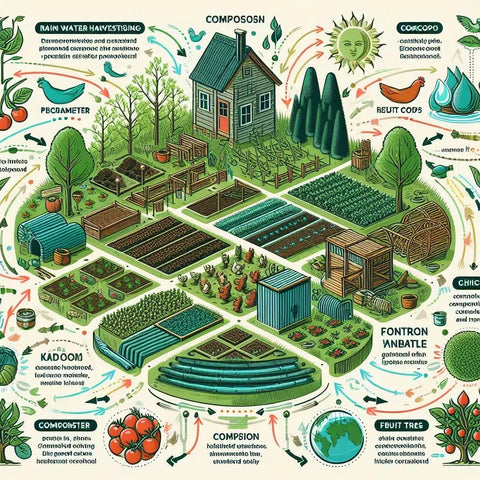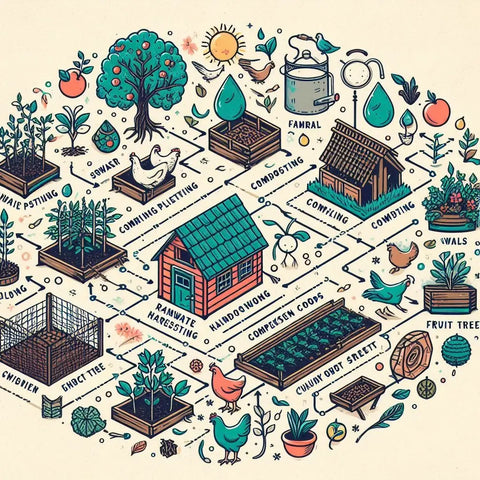The Sustainable Promise of Permaculture
Permaculture Design Principles and Practices
Nowadays, as the world is inevitably confronted with increasing ecological problems, permaculture, through its principles and methods, becomes the light of faith for those who want to live by nature. Permaculture, the practice of which is based on the integration of biological functions with each other and also providing food and shelter, is considered a parallel approach that could be an alternative to the conventional productive and intensive methods that have come to rule modern societies.

Permaculture consists of a set of deeply thought-through design fundamentals. These are the reins that hold practitioners and empower them to construct stable and self-sufficient ecosystems. These principles are not only principles, but the philosophy behind these conceptions inspires us to keep up with the nature around us, which involves our observation, interaction, and adaptation to it. When we come to grips with and act on these tenets, we discover the way to a more sustainable and meaningful way of organizing life.
Permaculture is organized around twelve conditions.
Observe and Interact:
Permaculture targets at the beginning point to establish a very profound appreciation of the indigenous/local environment, as well as its network of interdependent systems. Through its close observation of the prevailing natural patterns, the canvas on which the permaculture designers draw looks for opportunities to harmonize with the surrounding landscape and create integrated systems that function synergistically with the landscape.
Catch and Store Energy:
Permaculture makes us realize that renewable or non-renewable resources have to be conserved and used properly, and it doesn't matter what types of these resources they are: sunlight, water, or organic matter. Based on this doctrine, they are going to apply such energy sources as solar, water harvesting, and composting systems to minimize waste while aiming to maximize productivity.
Obtain a Yield:
Although most people associate the idea of permaculture with self-reliance, it is simultaneously understood that a system has to produce on-ground results too. Through the development of systems that reliably give input, these communities would then be able to provide food, energy, or other resources, which would in turn create a thriving, self-sustaining community.
Apply Self-Regulation and Accept Feedback:
In applying the permaculture principle, practitioners are aware that every action bears any purpose whatsoever, not only the intended outcomes. Many times, the companies may not seem to provide solutions to customers' problems. Remote support is necessary for such issues, and it is the only way they may be able to make adjustments and adapt.
Use and Value Renewable Resources and Services:
Permaculture solutions provide for the implementation of renewable resources, inclusive of solar, wind, and biomass, as well as finite and non-renewable resources. The principle extends further to support the fact that all ecosystems, starting from the smallest, have countless "services" (such as the nutrition cycle and pest control).
Produce No Waste:
The permaculture vision is devoid of waste, as it is where human beings brainwash themselves. A neatly woven network is the goal of permaculture practitioners, who aim to achieve it using designing systems that use the cyclic nature of our natural ecosystems, thereby abstaining from waste and finding useful applications for all byproducts, eventually closing the input/output loops.
Design from Patterns to Details:
The concept of permaculture presents the essence of planning for the long term and, more importantly, paying attention to the overall relationships existing within the given system, well before the specifics. This practice assists designers in achieving the combination and connectedness of the system so that it is robust to dynamic changes.
Integrate Rather than Segregate:
The permaculture approach calls for the close combination of multiple facets within a system, i.e., plants, animals, and human work. Combining these approaches or using them together positively affects the creation of the most broad, mature, and productive ecosystems.
Use Small and Slow Solutions:
Permaculture accepts that people usually embrace changes slowly and through small or barely conspicuous steps. The embeddedness of a permaculture approach into a system's design constitutes the implementation of interventions of small scale and low impact that could, in such a way, increase its resilience and adaptability from a long-term perspective.
Use and Value Diversity:
The idea of permaculture is to acknowledge the natural ecological systems as having a high level of diversity. As such, a diversity of plant and animal species, people, and cultures, as well as methods, can lead to the system's life and environment becoming more robust and adaptive.
Use Edges and Value the Marginal:
Permaculture designers value and acknowledge the special characteristics of the areas that connect and separate different elements, which can be a place both for adaptation and protection. Through the effective use of these buffers, whether between large expansions of urban development, a watercourse, or a natural park, the human species can construct fascinating and varied interfaces that completely utilize these resources.
Creatively Use and Respond to Change:
Permaculture does make provision for the inevitability of change, wherein nature and humans are both included, as it assumes that change is a natural phenomenon. Adapting to changes shows that permaculture designers are flexible enough and prepared for challenges as well as for the emerging opportunities that may arise from the projects. As a result, their designs will be sustainable, as they can foresee the possible challenges.
Putting permaculture into practice
Principles of permaculture can go well in different sizes of places, from small gardens in cities to large farms. By implementing these ideologies in the design and service of our households, food production systems, and community initiatives, we can achieve the sustainability of ecosystems, which cope with and solve the issues of the environment and society today.
The focus of the permaculture approach is adaptability to local circumstances and developing the most suitable solutions in context. Every permaculture design that is undertaken is a unique process, thought out to the extent of the particular needs, resources, and opportunities of that locality and community. We believe that beginning the conversation from there, at the grass-roots level, highlights our world’s nature and helps promote deeper comprehension about and better results in indigenous areas.
- Establishing gardens that showcase the benefits of diversity as well as productivity that model nature ecosystems.
- Water preservation and accumulation are two of the techniques to be taken into consideration, which include rainwater catchment and greywater reclamation.
- Among renewables, energy systems like solar, wind, and decrowing are being lined up as possible substitutes.
- An approach to humanizing the environment uses ecologically sensitive, local materials and passive solar design.
- integrated livestock systems, which function as a holistic whole where figures of livestock and poultry are placed strategically across the layout.
- Community-targeted strategies like cooperative forecasts, joint resource management, and education activities could be the way forward.
Through the introduction of these diverse components abiding by the core principles of permaculture, people can build holistic and adaptable systems in which their own needs and desires are fulfilled and, at the same time, contribute to the well-being of their surroundings, with the result being the overall regeneration of the ecosystem.

Embracing the Permaculture Mindset
Frequently, the attractiveness of this design does not stop at simply providing a practical solution; it also brings about a new mindset, which in turn has substantial implications. In contrast to conventional farming methods, permaculture is an advanced agriculture system that creates deep knowledge about the interrelationships of all living things and systems in nature. Through this approach, sustainability encourages us to view the world as a system rather than a sum of individual parts by showing us the complex relationships between nature's components.
Such a change of mindset may act as a driving force that will lead us to be more eco-literate as consumers, producers, and stewards of the land. It engenders a sense of greater value for nature, the spirit of conservation, and a healthy environment for us all, including vegetation that sustains our lives. And, the core values of permaculture can be a bid to social, economic, and political issues, creating those societies that put more emphasis on equality, inclusiveness, and resilience.
Given the climate-change woes of the 21st century, permaculture fosters a great deal of practical guidance on the pathway to sustainability and regeneration. By recognizing these theories and implementing them, we will be able to develop a place to live that is not only comfortable and amenable to us but also has enough capabilities to sustain a prosperous life for future generations.





Leave a comment